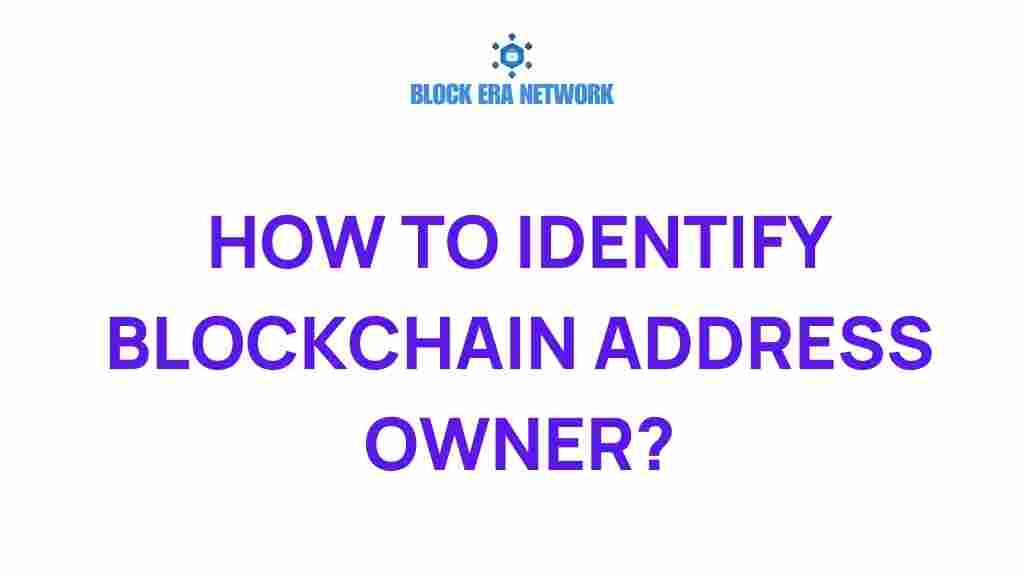Unveiling the Shadows: How to Identify Blockchain Address Owners
The rise of blockchain technology has revolutionized the way we perceive privacy and security in the digital world. While blockchains, particularly those supporting cryptocurrencies like Bitcoin and Ethereum, offer a certain level of pseudonymity, they are not entirely devoid of traceability. This article aims to delve into the intricate dimensions of address ownership on the blockchain, exploring methods to identify blockchain address owners while maintaining a focus on the implications for privacy, digital identity, and security in this evolving landscape.
Understanding Blockchain and Address Ownership
Blockchain technology operates on a decentralized ledger system where every transaction is recorded in a public database. Each user is assigned a unique alphanumeric address that serves as their identity in the network. However, this pseudonymity raises crucial questions about address ownership and the potential for privacy breaches.
- Pseudonymity: While users are not directly identified by their names, their transaction history is public.
- Traceability: All transactions are recorded and can be traced back to their origins.
- Forensic analysis: Techniques can be utilized to link addresses to individuals or entities.
The Importance of Address Ownership in Cryptocurrency
Identifying address ownership is essential for several reasons:
- Security: Understanding who owns which address can help prevent fraud and other malicious activities.
- Regulatory Compliance: Governments and regulatory bodies may require identification of address ownership for compliance with anti-money laundering (AML) and know your customer (KYC) regulations.
- Trust and Transparency: In a decentralized economy, knowing the owners behind addresses can build trust among users.
Methods for Identifying Blockchain Address Owners
While complete anonymity is a characteristic of blockchain technology, several methods can be employed to identify address ownership. Here’s a step-by-step process for conducting forensic analysis on blockchain addresses:
Step 1: Analyze Transaction History
The first step in identifying address ownership is to examine the transaction history associated with the address. Tools like blockchain explorers allow users to view all transactions linked to an address.
- Look for incoming and outgoing transactions.
- Note the frequency and volume of transactions.
- Identify patterns or connections with other addresses.
Step 2: Leverage Blockchain Analytics Tools
There are various blockchain analytics tools available that can help identify patterns and connections between addresses:
- Chainalysis: Provides detailed analytics and tracking for addresses.
- Elliptic: Offers tools for identifying illicit activity.
- CipherTrace: Helps in risk assessment and compliance.
Step 3: Correlate Data with External Sources
Many blockchain addresses are linked to exchanges or services that require identity verification. Cross-referencing transaction data with information from exchanges can lead to the identification of address owners. This typically involves:
- Identifying the exchange used.
- Reviewing KYC compliance data if available.
- Utilizing social media or other public data to create a profile.
Step 4: Monitor Behavioral Patterns
By observing the behavioral patterns of a specific address, you may be able to gain insights into its owner. This includes:
- Analyzing the timing and frequency of transactions.
- Identifying recurring addresses in transactions.
- Understanding spending habits, which can hint at the owner’s identity.
Step 5: Engage with the Community
Online communities and forums can be a valuable resource. Engaging with the community can help gather anecdotal evidence or reports regarding specific addresses. Platforms like Reddit or specialized cryptocurrency forums may have discussions that reveal insights about address ownership.
Troubleshooting Tips for Address Identification
Identifying address ownership can be challenging. Here are some troubleshooting tips to enhance your analysis:
- Be Cautious of Mixing Services: Some users employ mixing services to obfuscate their transaction trails. Recognizing and accounting for these services is vital.
- Stay Updated on Blockchain Developments: The landscape of blockchain technology is constantly evolving. New methods for maintaining privacy and anonymity continue to emerge.
- Consider Legal Limitations: Always keep in mind the legal and ethical implications of your analysis, especially regarding privacy rights.
Implications of Address Ownership Identification
The ability to identify address ownership has significant implications for individuals and organizations operating in the blockchain space:
- Privacy Concerns: Users may feel their privacy is compromised when their addresses are linked to their identities.
- Security Risks: Public knowledge of an address owner can expose them to targeted attacks or scams.
- Regulatory Scrutiny: Increased identification of address ownership may lead to stricter regulations on cryptocurrency transactions.
Conclusion
As blockchain technology continues to grow and evolve, the challenge of identifying address ownership will remain a pertinent issue. While the pseudonymous nature of blockchain offers some level of privacy, the potential for traceability and forensic analysis means that users must remain vigilant about their digital identities. Employing the methods outlined in this article will equip individuals and organizations to navigate the complex landscape of blockchain while being aware of the security and privacy implications involved.
For a deeper understanding of blockchain technologies and their implications on privacy, feel free to explore more resources on this topic. The balance between security and privacy in the digital age will continue to be a critical area of focus as we unveil the shadows surrounding address ownership in the blockchain realm.
This article is in the category Crypto Security and created by Block Era Network Team
